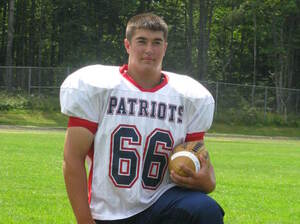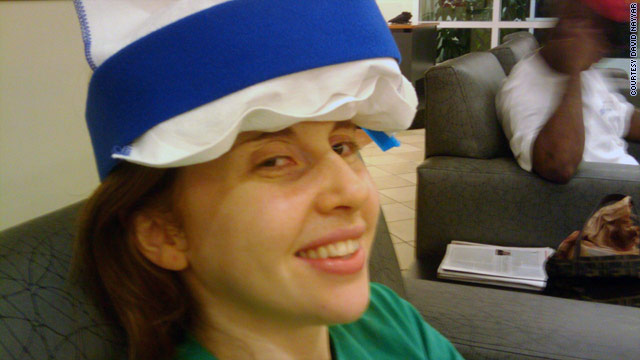A febrile seizure is a convulsion in a child triggered by a fever. These convulsions occur without any brain or spinal cord infection or other nervous system (neurologic) cause.
Causes
About 3 - 5% of otherwise healthy children between ages 9 months and 5 years will have a seizure caused by a fever. Toddlers are most commonly affected. Febrile seizures often run in families.
Most febrile seizures occur in the first 24 hours of an illness, and not necessarily when the fever is highest. The seizure is often the first sign of a fever or illness
Febrile seizures are usually triggered by fevers from:
- Ear infections
- Roseola infantum (a condition with fever and rash caused by several different viruses)
- Upper respiratory infections caused by a virus
Meningitis causes less than 0.1% of febrile seizures but should always be considered, especially in children less than 1 year old, or those who still look ill when the fever comes down.
A child is likely to have more than one febrile seizure if:
- There is a family history of febrile seizures
- The first seizure happened before age 12 months
- The seizure occurred with a fever below 102 degrees Fahrenheit
Symptoms
A febrile seizure may be as mild as the child's eyes rolling or limbs stiffening. Often a fever triggers a full-blown convulsion that involves the whole body.
Febrile seizures may begin with the sudden contraction of muscles on both sides of a child's body -- usually the muscles of the face, trunk, arms, and legs. The child may cry or moan from the force of the muscle contraction. The contraction continues for several seconds, or tens of seconds. The child will fall, if standing, and may pass urine.
The child may vomit or bite the tongue. Sometimes children do not breathe, and may begin to turn blue.
Finally, the contraction is broken by brief moments of relaxation. The child's body begins to jerk rhythmically. The child does not respond to the parent's voice.
A simple febrile seizure stops by itself within a few seconds to 10 minutes. It is usually followed by a brief period of drowsiness or confusion. A complex febrile seizure lasts longer than 15 minutes, is in just one part of the body, or occurs again during the same illness.
Febrile seizures are different than tremors or disorientation that can also occur with fevers. The movements are the same as in a grand mal seizure.
Exams and Tests
The health care provider may diagnose febrile seizure if the child has a grand mal seizure but does not have a history of seizure disorders (epilepsy). In infants and young children, it is important to rule out other causes of a first-time seizure, especially meningitis.
In a typical febrile seizure, the examination usually shows no abnormalities other than the illness causing the fever. Typically, the child will not need a full seizure workup, which includes an EEG, head CT, and lumbar puncture (spinal tap).
To avoid having to undergo a seizure workup:
- The child must be developmentally normal.
- The child must have had a generalized seizure, meaning that the seizure was in more than one part of the child's body, and not confined to one part of the body.
- The seizure must not have lasted longer than 15 minutes.
- The child must not have had more than one febrile seizure in 24 hours.
- The child must have a normal neurologic exam performed by a health care provider.
Treatment
During the seizure, leave your child on the floor.
- You may want to slide a blanket under the child if the floor is hard.
- Move him only if he is in a dangerous location.
- Remove objects that may injure him.
- Loosen any tight clothing, especially around the neck. If possible, open or remove clothes from the waist up.
- If he vomits, or if saliva and mucus build up in the mouth, turn him on his side or stomach. This is also important if it looks like the tongue is getting in the way of breathing.
Do NOT try to force anything into his mouth to prevent him from biting the tongue, as this increases the risk of injury. Do NOT try to restrain your child or try to stop the seizure movements.
Focus your attention on bringing the fever down:
- Insert an acetaminophen suppository (if you have some) into the child's rectum.
- Do NOT try to give anything by mouth.
- Apply cool washcloths to the forehead and neck. Sponge the rest of the body with lukewarm (not cold) water. Cold water or alcohol may make the fever worse.
- After the seizure is over and your child is awake, give the normal dose of ibuprofen or acetaminophen.
After the seizure, the most important step is to identify the cause of the fever.
Outlook (Prognosis)
The first febrile seizure is a frightening moment for parents. Most parents are afraid that their child will die or have brain damage. However, simple febrile seizures are harmless. There is no evidence that they cause death, brain damage, epilepsy, mental retardation, a decrease in IQ, or learning difficulties.
A small number of children who have had a febrile seizure do go on to develop epilepsy, but not because of the febrile seizures. Children who would develop epilepsy anyway will sometimes have their first seizures during fevers. These are usually prolonged, complex seizures.
Nervous system (neurologic) problems and a family history of epilepsy make it more likely that the child will develop epilepsy. The number of febrile seizures is not related to future epilepsy.
About a third of children who have had a febrile seizure will have another one with a fever. Of those who do have a second seizure, about half will have a third seizure. Few children have more than three febrile seizures in their lifetime.
Most children outgrow febrile seizures by age 5.
Possible Complications
- Biting oneself
- Breathing fluid into the lungs
- Complications if a serious infection, such as meningitis, caused the fever
- Injury from falling down or bumping into objects
- Injury from long or complicated seizures
- Seizures not caused by fever
- Side effects of medications used to treat and prevent seizures (if prescribed)
When to Contact a Medical Professional
Children should see a doctor as soon as possible after their first febrile seizure.
If the seizure is lasting several minutes, call 911 to have an ambulance bring your child to the hospital.
If the seizure ends quickly, drive the child to an emergency room when it is over.
Take your child to the doctor if repeated seizures occur during the same illness, or if this looks like a new type of seizure for your child.
Call or see the health care provider if other symptoms occur before or after the seizure, such as:
It is normal for children to sleep or be briefly drowsy or confused right after a seizure.
Prevention
Because febrile seizures can be the first sign of illness, it is often not possible to prevent them. A febrile seizure does not mean that your child is not getting the proper care.
Occasionally, a health care provider will prescribe diazepam to prevent or treat febrile seizures that occur more than once. However, no medication is completely effective in preventing febrile seizures.
Alternative Names
Seizure - fever induced
References
Johnston MV. Seizures in childhood. In: Kliegman RM, Behrman RE, Jenson HB, Stanton BF, eds. Nelson Textbook of Pediatrics. 18th ed. Philadelphia, Pa: Saunders Elsevier; 2007:chap 593.
Update Date: 2/11/2010
Updated by: David C. Dugdale, III, MD, Professor of Medicine, Division of General Medicine, Department of Medicine, University of Washington School of Medicine. Also reviewed by David Zieve, MD, MHA, Medical Director, A.D.A.M., Inc.






